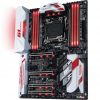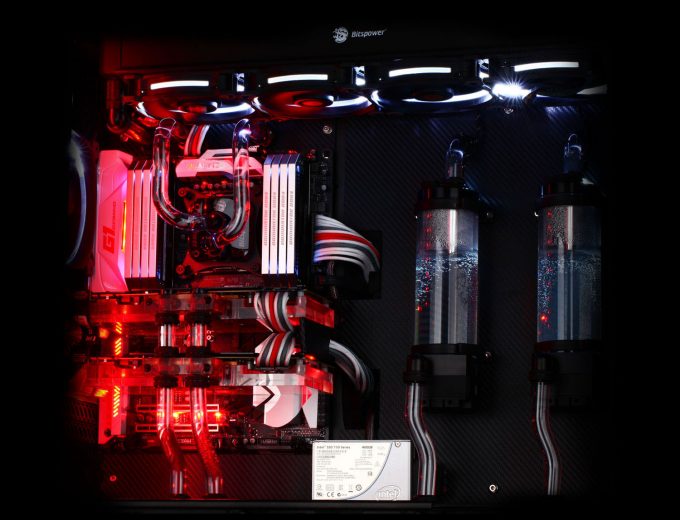- Qualcomm Launches Snapdragon 4 Gen 2 Mobile Platform
- AMD Launches Ryzen PRO 7000 Series Mobile & Desktop Platform
- Intel Launches Sleek Single-Slot Arc Pro A60 Workstation Graphics Card
- NVIDIA Announces Latest Ada Lovelace Additions: GeForce RTX 4060 Ti & RTX 4060
- Maxon Redshift With AMD Radeon GPU Rendering Support Now Available
GIGABYTE X99-Ultra Gaming Motherboard Review

Building a powerhouse gaming or workstation PC requires a solid motherboard as a base, and GIGABYTE’s X99-Ultra Gaming has proven to be just that. This ~$249 offering is packed to the gills with features, including at the very least a plethora of LEDs that can spice up any build.
Page 3 – Performance & Final Thoughts
Unlike most of our other motherboard reviews, this one isn’t going to compare the X99-Ultra Gaming to a similar motherboard from GIGABYTE’s own lineup, or even a competitor’s. That’s simply because this is likely to be our only X99 (v2) look, as what’s sure to have more interest going forward are boards updated for Intel’s Kaby Lake lineup (eg: Z270).
That said, without a comparison to a similar motherboard, I’ve opted to compare GIGABYTE’s X99-Ultra Gaming when equipped with a 10-core Core i7-6950X against ASUS’ first-gen X99-DELUXE, equipped with the 8-core i7-5960X.
Given this odd route we’re taking, this testing is clearly not apples-to-apples; it’s more of a way to show the differences between these two high-end platforms, with the ultimate goal being that we can see GIGABYTE’s board hold up, and deliver the results we’d expect.
| Test Systems | |
| Processor | Intel Core i7-5960X – Eight-Core, 3.00GHz (3.5GHz Turbo) Intel Core i7-6950X – Ten-Core, 3.00GHz (3.5GHz Turbo) |
| Motherboard | ASUS X99-DELUXE (i7-5960X; BIOS: 3101) GIGABYTE X99-Ultra Gaming (i7-6950X; BIOS: F5) |
| Memory | 4GB x 8 Kingston HyperX Fury @ DDR4-2133 15-15-15-36 8GB x 4 G.SKILL Trident Z @ DDR4-2133 15-15-15-36 |
| Graphics | NVIDIA GeForce GTX 1060 (GeForce 373.06 Driver) |
| Audio | Onboard |
| Storage | Kingston HyperX 3K 480GB SSD |
| Power Supply | Corsair AX1200 |
| Chassis | Corsair Obsidian 800D Full-Tower |
| Cooling | Corsair H100i v2 (i7-6950X) Thermaltake WATER3.0 Extreme (i7-5960X) |
| Et cetera | Windows 10 Pro 64-bit |
One way vendors could improve their performance positioning is by giving their BCLK a small, seemingly insignificant boost. No such thing is done across these two boards. The memory is even run at the exact same speeds, automatically.
| BCLK Values | Memory Speed | Memory Timings | |
| ASUS X99-DELUXE | 99.94 MHz | DDR4-2133 | 15-15-15-36 |
| GIGABYTE X99-Ultra Gaming | 99.98 MHz | DDR4-2133 | 15-15-15-36 |
With that validated, let’s get into some test results.
General System Performance
To take a look at the “overall” performance of our PC configuration, we rely on dual Futuremark suites: PCMark 8 and 3DMark (2013), as well as dual SPEC suites, SPECwpc and SPECviewperf, and also Unigine’s Heaven.
| SPECwpc 2.0 | Media | Financial | Development | Energy | Sciences | General |
| ASUS X99-DELUXE 1 | 2.81 | 2.05 | 2.11 | 3.19 | 2.74 | 0.95 |
| GIGABYTE X99-Ultra Gaming 2 | 3.45 | 2.91 | 2.34 | 3.82 | 3.19 | 0.92 |
| Higher results are better. (1 i7-5960X; 2 i7-6950X) | ||||||
| SPECviewperf 12 | CATIA | Creo | Energy | Maya | Medical | Showcase | SNX | SW |
| ASUS X99-DELUXE 1 | 51.40 | 33.84 | 6.14 | 102.35 | 31.81 | 60.13 | 5.91 | 45.06 |
| GIGABYTE X99-Ultra Gaming 2 | 51.43 | 34.19 | 6.14 | 102.34 | 31.65 | 56.82 | 5.94 | 45.33 |
| Higher results are better. (1 i7-5960X; 2 i7-6950X) | ||||||||
| SPECapc 3ds Max 2015 | CPU | GPU | Large Model |
| ASUS X99-DELUXE 1 | 5.68 | 4.36 | 4.32 |
| GIGABYTE X99-Ultra Gaming 2 | 6.41 | 4.50 | 4.47 |
| Higher results are better. (1 i7-5960X; 2 i7-6950X) | |||
| PCMark 8 Suite Scores | Home | Work | Creative |
| ASUS X99-DELUXE 1 | 5105 | 5515 | 7837 |
| GIGABYTE X99-Ultra Gaming 2 | 5173 | 5619 | 7692 |
| Higher results are better. (1 i7-5960X; 2 i7-6950X) | |||
| 3DMark (2013) | 3DMark | Graphics | Physics |
| ASUS X99-DELUXE 1 | 11387 | 13128 | 15912 |
| GIGABYTE X99-Ultra Gaming 2 | 11617 | 13039 | 20523 |
| Fire Strike test. 3DMark results in points; higher is better. (1 i7-5960X; 2 i7-6950X) | |||
| Unigine Heaven 4.0 | 1920×1080 | 2560×1440 | ||||
| ASUS X99-DELUXE 1 | 100 FPS | 56 FPS | ||||
| GIGABYTE X99-Ultra Gaming 2 | 99 FPS | 57 FPS | ||||
| Higher results are better. (1 i7-5960X; 2 i7-6950X) | ||||||
Considering the fact that the i7-6950X offers 25% more cores over the i7-5960X, we can use that as a performance ballpark. That’s a safe bet, although in some cases, it doesn’t quite live up, whereas in other cases, it exceeds what we’d expect. In SPECwpc’s Financial test, for example, the 10-core proves 40% faster. In most others, though, the average gain is around 20%.
There’s a slight improvement in 3DMark to be seen, although it’s likely largely to do with the multi-core capable physics test. In Unigine, both chips are identical in performance.
Rendering & Image Manipulation
Writing files to disk or reading a website doesn’t do much to exercise our CPU, so for that, we turn to a few common scenarios – image editing, video rendering, music conversion, and 3D rendering.
| Adobe Lightroom CC (2015.7) | Result |
| ASUS X99-DELUXE 1 | 234 s |
| GIGABYTE X99-Ultra Gaming 2 | 214 s |
| Results in seconds; lower is better. (1 i7-5960X; 2 i7-6950X) | |
| Adobe Premiere Pro CC | 4K Encode | Music Video | PPBM9 |
| ASUS X99-DELUXE 1 | 99 s | 123 s | 77 s |
| GIGABYTE X99-Ultra Gaming 2 | 100 s | 103 s | 68 s |
| Results in seconds; lower is better. (1 i7-5960X; 2 i7-6950X) | |||
| Autodesk 3ds Max 2017 | Naomi Render | iray Render |
| ASUS X99-DELUXE 1 | 731 s | 1395 s |
| GIGABYTE X99-Ultra Gaming 2 | 619 s | 1021 s |
| Results in seconds; lower is better. (1 i7-5960X; 2 i7-6950X) | ||
| Cinebench R15 | OpenGL | CPU |
| ASUS X99-DELUXE 1 | 156.35 FPS | 1328 cb |
| GIGABYTE X99-Ultra Gaming 2 | 161.58 FPS | 1791 cb |
| Higher results are better. (1 i7-5960X; 2 i7-6950X) | ||
| dBpoweramp R15 | FLAC to MP3 |
| ASUS X99-DELUXE 1 | 137 s |
| GIGABYTE X99-Ultra Gaming 2 | 111 s |
| 250 FLAC to 320Kbps MP3. (1 i7-5960X; 2 i7-6950X) | |
| HandBrake 0.10.5.0 | H.265 Encode | H.264 Encode |
| ASUS X99-DELUXE 1 | 532 s | 90 s |
| GIGABYTE X99-Ultra Gaming 2 | 414 s | 74 s |
| Results in seconds; lower is better. 4K encode. (1 i7-5960X; 2 i7-6950X) | ||
| POV-Ray | Single-Thread | Multi-Thread |
| ASUS X99-DELUXE 1 | 328.53 | 2694.18 |
| GIGABYTE X99-Ultra Gaming 2 | 348.85 | 3563.82 |
| Higher is better. (1 i7-5960X; 2 i7-6950X) | ||
GIGABYTE’s X99-Ultra Gaming holds up well when containing the beast that is the 10-core i7-6950X. The differences between the 8- and 10-core are not enormous – especially not to warrant a $600 premium over the 8-core, but when you need to have the best, you can expect to see solid gains across most workloads.
Sub-system Performance
For memory and CPU testing, we utilize SiSoftware’s Sandra 2016 SP3.
| Sandra 2016 SP3 (Memory) | Bandwidth | Latency |
| ASUS X99-DELUXE 1 | 47.91 GB/s | 30.2 ns |
| GIGABYTE X99-Ultra Gaming 2 | 44.91 GB/s | 29.8 ns |
| Bandwidth results; higher is better. Latency results; lower is better. (1 i7-5960X; 2 i7-6950X) | ||
| Sandra 2016 SP3 (Arithmetic) | Dhrystone (Integer AVX2) | Whetstone (Single Float) |
| ASUS X99-DELUXE 1 | 206 GIPS | 175 GFLOPS |
| GIGABYTE X99-Ultra Gaming 2 | 267 GIPS | 240 GFLOPS |
| Higher is better. (1 i7-5960X; 2 i7-6950X) | ||
| Sandra 2016 SP3 (Multi-Media) | Integer | Single-float |
| ASUS X99-DELUXE 1 | 696 MPix/s | 650 MPix/s |
| GIGABYTE X99-Ultra Gaming 2 | 793 MPix/s | 804 MPix/s |
| Higher is better. (1 i7-5960X; 2 i7-6950X) | ||
Interestingly, the memory bandwidth result saw a decline on the i7-6950X, although it might possibly have something to do with the fact that 8 DIMMs were used instead of 4. Nonetheless, this memory bandwidth is huge, so it’s incredibly unlikely that anyone would notice the difference in the real-world, outside of server workloads.
In the arithmetic tests, the i7-6950X performed better than an increase of 25%, thanks to architectural enhancements. Smaller gains were seen in the multi-media tests, though.
Final Thoughts
There’s not too much to dislike about GIGABYTE’s X99-Ultra Gaming, and in fact, I’m having a hard time coming up with a major complaint. It’s not hard to find things to like, though, and with what’s provided, the board’s suggested price of about ~$250 is almost impressive – this thing is packed.
At the forefront, the X99-Ultra Gaming doesn’t hold anything back with regards to the functionality. It includes 10x 6Gbps SATA ports, SATA Express, M.2 for storage and Wi-Fi, as well as U.2. It also includes 6x USB 3.0 ports at the back, as well as 3.1 Type-A and Type-C ports, with further expansion provided through internal connectors.
A note on Thunderbolt: support will have to be added with an add-in card, and as it happens, GIGABYTE makes one. However, I couldn’t find that card in stock anywhere but one website that was selling it for nearly $70. My recommendation: if you require a Thunderbolt port, look at motherboards that are certified for Thunderbolt 3.0 out-of-the-box. If Thunderbolt isn’t needed, the USB 3.1 Type-A and Type-C ports should suffice, offering up to 10Gbps of bandwidth each. That’s a lot of breathing room.
Beyond things like connectivity, GIGABYTE’s X99-Ultra Gaming includes a solid EFI (though I think some improvements would be nice – a mouse should never be needed!) and software stack, and packs the board to the gills with bling. The biggest part of that is with the customizable LEDs: changing their color to better match the rest of your build is only a couple of mouse clicks away.
Other nice features include the Killer E2400 networking chip, along with its related software, “Armor” for the memory DIMM and PCIe slots, a headphone amplifier, dual “Hybrid Fan Headers” (able to control pump and fan separate), and what I’d consider a great board design. The only thing I’d personally complain about lacking is the BIOS LED readout, which is useful for debugging (sometimes, anyway).
Overall, I am left extremely impressed with GIGABYTE’s X99-Ultra Gaming, and given its price point and all of it offers, I can easily recommend it to anyone looking to build a new X99-based build.
Pros
- Lots of SATA and USB, includes USB 3.1 Type-A and Type-C.
- Includes M.2 for storage and Wi-Fi, as well as U.2.
- Onboard customizable LEDs are a great touch.
- Includes dual LAN solutions: Intel and Killer.
- EFI and software stack are well-designed and useful.
- Great board layout / design.
- Well-priced.
Cons
- No LED BIOS code readout.
- No onboard power/reset buttons.
- EFI leaves a bit to be desired. PC Health screen doesn’t show temperatures.

GIGABYTE X99-Ultra Gaming Motherboard
Support our efforts! With ad revenue at an all-time low for written websites, we're relying more than ever on reader support to help us continue putting so much effort into this type of content. You can support us by becoming a Patron, or by using our Amazon shopping affiliate links listed through our articles. Thanks for your support!






